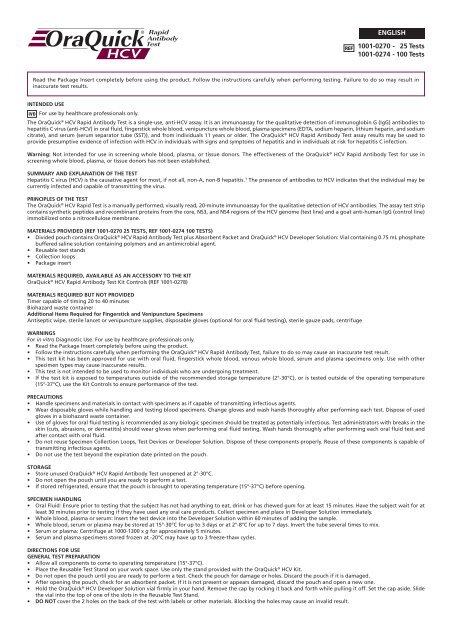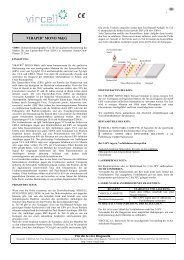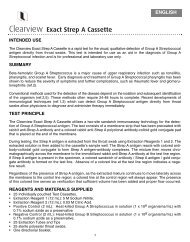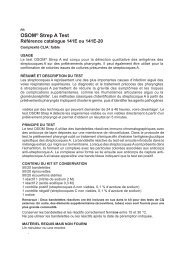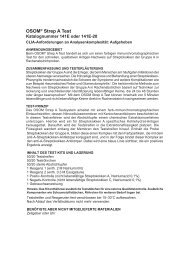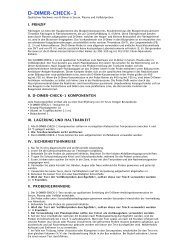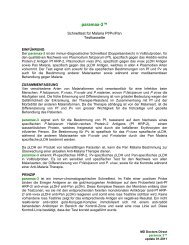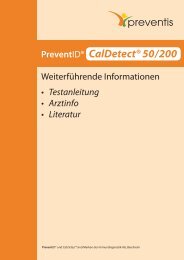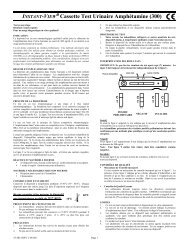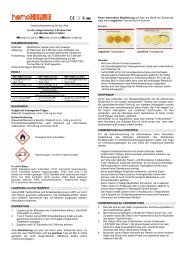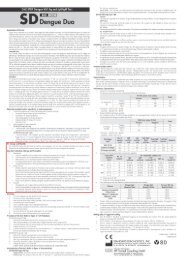OQ CE HCV A4 PI_GB:Layout 1 - OraSure Technologies, Inc.
OQ CE HCV A4 PI_GB:Layout 1 - OraSure Technologies, Inc.
OQ CE HCV A4 PI_GB:Layout 1 - OraSure Technologies, Inc.
You also want an ePaper? Increase the reach of your titles
YUMPU automatically turns print PDFs into web optimized ePapers that Google loves.
PERFORMAN<strong>CE</strong> CHARACTERISTICSSENSITIVITYThe sensitivity of OraQuick ® <strong>HCV</strong> Rapid Antibody Test was assessed in symptomatic and/or at-risk individuals determined to be <strong>HCV</strong> infected. Sensitivity for eachof the five specimen matrices was calculated by dividing the number of OraQuick ® <strong>HCV</strong> Rapid Antibody Test reactive results by the total number of specimens testedfrom <strong>HCV</strong> infected individuals (N). Results with the 95% confidence intervals (CI) for all five specimen matrices are summarized in the table below.Specimen Reactive Total N Sensitivity 95% CIOral Fluid 739 753 98,1% 96,9-99,0%Fingerstick WB 752 754 99,7% 99,0-100,0%Venipuncture WB 753 755 99,7% 99,0-100,0%Plasma 755 756 99,9% 99,3-100,0%Serum 756 757 99,9% 99,3-100,0%SPECIFICITYSpecificity of the OraQuick ® <strong>HCV</strong> Rapid Antibody Test was assessed in symptomatic and/or risk individuals who were determined not to be <strong>HCV</strong> infected. Thepercent specificity of the OraQuick ® <strong>HCV</strong> Rapid Antibody Test for each of the five specimen matrices was calculated by dividing the number of OraQuick ® <strong>HCV</strong> RapidAntibody Test non-reactive result by the total number of specimens tested that were derived from subjects determined not to be <strong>HCV</strong> infected (N). Results withthe 95% confidence intervals (CI) for all five specimen matrices are summarized in the table below.Non-Specimen Reactive Total N Specificity 95% CIOral Fluid 1418 1423 99,6% 99,2-99,9%Fingerstick WB 1421 1422 99,9% 99,6-100,0%Venipuncture WB 1421 1423 99,9% 99,5-100,0%Plasma 1420 1422 99,9% 99,5-100,0%Serum 1422 1423 99,9% 99,6-100,0%REACTIVITY WITH <strong>HCV</strong> SEROCONVERSION PANELSThirty panels containing sequential plasma specimens from individuals undergoing seroconversion as a result of <strong>HCV</strong> infection were evaluated with the OraQuick ®<strong>HCV</strong> Rapid Antibody Test and compared with a <strong>CE</strong> approved anti-<strong>HCV</strong> EIA test. The sensitivity of the OraQuick ® <strong>HCV</strong> Rapid Antibody Test to detect seroconversionwas similar to that of the <strong>CE</strong> approved EIA. The OraQuick ® <strong>HCV</strong> Rapid Antibody Test detected anti-<strong>HCV</strong> antibodies to <strong>HCV</strong> 0.6 days (95% CIs 0.1 to 1.4) before theEIA test at the 20-minute read time and the OraQuick ® <strong>HCV</strong> Rapid Antibody Test detected antibodies to <strong>HCV</strong> 0.9 days (95% CIs 0.03 to 1.8) before the EIA test atthe 40-minute read time.REACTIVITY WITH <strong>HCV</strong> SPECIMENS FROM VARIOUS GENOTYPES AND SUBTYPESThe ability of the OraQuick ® <strong>HCV</strong> Rapid Antibody Test to detect infection derived from various genotypes and subtypes was assessed using two commerciallyavailable Worldwide <strong>HCV</strong> Performance panels. Thirty-two <strong>HCV</strong>-positive plasma specimens derived from multiple geographies, representing six genotypes andeleven subtypes (1, 1a, 1b, 1a/b, 2, 2a, 2a/c, 3, 3a, 3b, 3a/b, 4, 4a, 4c/d, 4h, 5a, and 6a) were tested. All specimens were reactive with the OraQuick ® <strong>HCV</strong> RapidAntibody Test. Three <strong>HCV</strong>-negative samples were included in the panel and all were non-reactive with the OraQuick ® <strong>HCV</strong> Rapid Antibody Test.MEDICAL CONDITIONS UNRELATED TO <strong>HCV</strong> INFECTIONThe performance of the OraQuick ® <strong>HCV</strong> Rapid Antibody Test was evaluated with commercially available <strong>HCV</strong> negative plasma and serum specimens derived fromtwenty-one medical conditions unrelated to <strong>HCV</strong> infection. Results are summarized in the table below.Medical Condition N Non-Reactive (%) Reactive (%)Autoimmune DiseasesMyasthenia Gravis 4 4(100) 0(0)Rheumatoid Arthritis 10 10(100) 0(0)Scleroderma 20 19(95) 1(5)Sjögren’s Syndrome 20 19(95) 1(5)Systemic Lupus Erythematosus (SLE) 10 10(100) 0(0)Other Medical ConditionsInfluenza Vaccination 10 10(100) 0(0)Hepatitis A Virus (HAV) 20 19(95) 1(5)Hepatitis B Virus (HBV) 20 19(95) 1(5)Hepatitis D Virus (HDV) 2 2(100) 0(0)Hepatitis E Virus (HEV) 8 8(100) 0(0)Human T-Cell Lymphotropic Virus (HTLV I/II) 20 19(95) 1(5)Epstein-Barr Virus (EBV) 10 10(100) 0(0)Cytomegalovirus (CMV) 10 10(100) 0(0)Herpes Simplex Virus (HSV) 10 10(100) 0(0)Parvovirus B19 10 10(100) 0(0)Rubella 10 10(100) 0(0)Syphilis 10 10(100) 0(0)Toxoplasmosis 10 10(100) 0(0)Human Immunodeficiency Virus (HIV-1/2) 20 19(95) 1(5)Heterophilic Antibodies 10 10(100) 0(0)Multiparous Female 10 10(100) 0(0)Total Samples Tested 254 248 6
Of the twenty-one unrelated conditions tested, six produced any consistently reactive result with the OraQuick ® <strong>HCV</strong> Rapid Antibody Test that were not due to an<strong>HCV</strong> co-infection (Scleroderma, Sjögren’s Syndrome, Hepatitis A, Hepatitis B, HTLV, and HIV). Each of these unrelated medical conditions produced only a singlereactive result in the twenty specimens from patients with that condition. None of the medical conditions tested produced an unacceptably high rate of falsepositive results in the OraQuick ® <strong>HCV</strong> Rapid Antibody Test device.INTERFERING SUBSTAN<strong>CE</strong>SThe OraQuick ® <strong>HCV</strong> Rapid Antibody Test was evaluated with the following interfering substance. None of these interfering substances had any impact on theOraQuick ® <strong>HCV</strong> Rapid Antibody Test assay performance at the concentrations listed.Interfering SubstancesBilirubinHemoglobinLipid (Triolein)ProteinConcentration10 mg/dL500 mg/dL3500 mg/dL12 mg/dLIn addition, a study was performed to assess the potential effect of anticoagulants on assay performance. Venipuncture whold blood specimens were collected from50 <strong>HCV</strong> negative subjects and tested for eleven (11) conditions that consisted of three (3) sample types: whole blood, plasma, and serum; two (2) tube types: glassand plastic; and four (4) anticoagulant types: EDTA, lithium heparin, sodium citrate, and sodium heparin, as well as serum in SST. Each of the sample types wasaliquoted into vials marked positive and negative and then the positive aliquots were spiked with an <strong>HCV</strong> positive specimen. The aliquoted tubes were then storedeither refrigerated (2°-8°C) or at room temperature (30°C ± 3°C). Serum and plasma aliquots were also stored frozen at (-10°C to -20°C) for up to three (3) freezethaw cycles. There was no anticoagulant-specific effect observed on assay performance with samples held up to 7 days at 2°-8°C, 3 days at 30°C ± 3°C and up to3 freeze thaw cycles at -10°C to -20°C.ORAL INTERFEREN<strong>CE</strong>The OraQuick ® <strong>HCV</strong> Rapid Antibody Test was evaluated with the following interfering substance: Gingivitis, Dentures, Tobacco (Smokeless), Food & Beverage(Standardized Food, Acidic Beverage, Common Beverage, Basic Beverage, Alcoholic Beverage), Oral Care Products (Tooth brushing, mouthwash, tooth whitening),and Medications (Aspirin, Warfarin/Coumadin/Jantoven). None of these interfering substances had any impact on the OraQuick ® <strong>HCV</strong> Rapid Antibody Test assayperformance with a wait period of 15 minutes for food and drink and 30 minutes for oral care products.REPRODUCIBILITYThe reproducibility of the OraQuick ® <strong>HCV</strong> Rapid Antibody Test was tested at 3 sites using 3 lots of Test Devices on 5 different days with 9 operators (3 per site). Ablinded panel was tested that consisted of 3 plasma specimens (1 negative, 1 low positive, and 1 moderate positive). Overall concordance across operators, sitesand device lots was 100% (95% CIs 99,5-100%) for the negative specimen, 100% (95% CIs 99,5-100%) for the low positive specimen and 99,9% (95% CIs 99,3-100%)for the moderate positive specimen.BIBLIOGRAPHY1. Q-L Choo, A.J. Weiner, L.R. Overby, G. Kuo, M. Houghton, and D.W. Bradley, Hepatitis C Virus: The Major Causative Agent of Viral Non-A, Non-B Hepatitis.British Medical Bulletin. 1990; Vol. 46, No. 2:423-441.2. L.M. Sehulster, F.B. Hollinger, G.R. Dreesman, and J.L. Melnick, Immunological and Biophysical Alteration of Hepatitis B Virus Antigens by Sodium HypochloriteDisinfection. Appl. Environ. Microbiol. 1981; 42(5):762-767.


